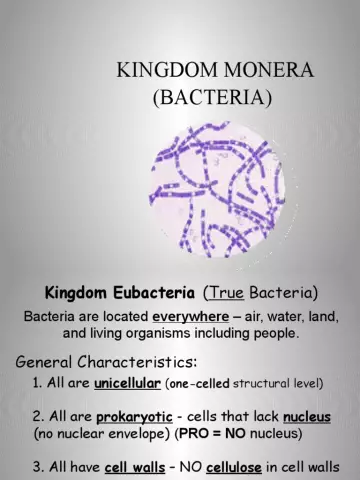- Author Curtis Blomfield [email protected].
- Public 2023-12-16 20:44.
- Last modified 2025-01-23 17:01.
Roughly since the end of the 19th century, scientists began to accumulate knowledge about the differences between pro- and eukaryotic cells, and so gradually isolated a separate kingdom of microorganisms, united by the lack of cell differentiation, - Protista. However, what bacteria are, at that time they only had to study: only in the 20th century. this knowledge has been systematized.

Bacteria are located in all environments where organic matter can accumulate. They tolerate high and low temperatures, salinity and acidity. Thus, the kingdom of bacteria lives not only in the environment, where they decompose organic matter for their life activity, but also densely populates many mucous membranes of animals and humans, helping to digest food and competing with pathogenic microorganisms. Their role in nitrogen metabolism is especially great, since only cyanobacteria are able to process atmospheric nitrogen. However, some bacteria are the causative agents of diseases: plague, anaerobic and intestinal infections, syphilis, cholera and anthrax.
Morphology

The ultrastructure of bacteria can only be seen with an electron microscope, but what bacteria are and how they look on the outside can also be seen with immersion microscopy using special staining techniques. The sizes of these microorganisms vary from 0.1 to 10 microns, but the morphology of bacteria allows us to divide them into 3 main groups: spherical - cocci (mono-, diplo-, tetra-, streptococci and sarcines), rod-shaped - bacilli (mono-, diplo-, strepto-) and convoluted - vibrios, spirilla and spirochetes. In laboratory conditions, to determine the type and enzymatic properties, they are grown on simple or special nutrient media by forming colonies, and in different media they have a different growth pattern.
Building

In general, what bacteria are is determined by their ultrastructure. Outside, bacteria are protected by a cell wall consisting of layers of peptidoglycan, lipids, and teichoic acids. The concentration of the former determines the ability of bacteria to stain according to the Gram method in a smear, according to which they are classified into Gr + and Gr-. Some of them have an additional protective structure - a capsule containing the K-antigen and preventing their phagocytosis inside the macroorganism, the action of toxic and mechanical factors. To learn more about what bacteria are, you need to study their intracellular structure: bacteria are filled with cytoplasm, in which other organelles (ribosomes, chromatophores) and nutrient inclusions (lipids, sugars) are dissolved. They are likeand all prokaryotes do not have a formalized nucleus, and all genetic information is stored in a double-stranded nucleic acid molecule located in the nucleoid zone and fixed to the membrane at one point. Outside of it, genetic information is contained in plasmids that can determine the development of pathogenic properties and factors. For movement, they use flagella and spirilla, fixed in the cell by a basal body, and their reproduction occurs by dividing in two.






